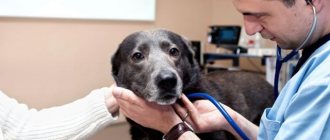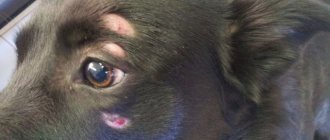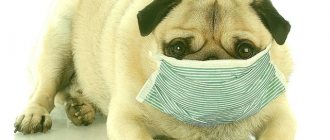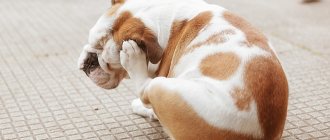Let's take a closer look at the question - what to do if a dog squints its eyes? Eye problems are a fairly common occurrence among pets, including dogs, regardless of age and breed. Every owner has noticed at least once with their animal that their pet has begun to close its eyes.
Diseases
Almost all eye pathologies at an early stage force the dog to cover its eyes. This happens due to the onset of the inflammatory process.
Conjunctivitis
This is an infectious disease in which the mucous membrane becomes inflamed. In this case, profuse purulent discharge is formed.
By squinting, the dog moistens the cornea, reducing pain.
Dry eye syndrome
This is a severe ophthalmological disease in animals. During inflammation, the lacrimal gland does not work well, the cornea and eyelid dry out, and the conjunctiva is affected. Dry eyes are susceptible to infections and viruses.
At the first stage, purulent conjunctivitis develops, then keratitis.
At the last stage of the disease, if there is no treatment, the dog will become completely blind.
Corneal ulcer
Another name for the disease is ulcerative keratitis. With this pathology, the upper epithelial layer of the cornea becomes ulcerated. The disease is painful for the pet as it causes severe pain.
Blepharitis
If an animal's eyelids are swollen, this is blepharitis. At the same time, the dog is overly anxious or, on the contrary, lethargic and avoids any contact.
Other symptoms of the disease:
- photophobia;
- redness and enlargement of the eyelids;
- the animal practically cannot raise its eyelids;
- suppuration;
- profuse lacrimation.
At the first signs of the disease, eye drops are used.
Associated symptoms
Depending on the cause, squinting may be associated with other worrying symptoms. These include:
- apathy or aggression;
- poor appetite and sleep disturbances;
- redness and inflammation of the conjunctiva;
- excessive tearing or the appearance of purulent discharge;
- clouding of the iris, strabismus and prolapse of the third eyelid;
- increase or decrease in temperature;
- enlargement of the pupil and the appearance of a greenish cataract;
- gluing of eyelashes and formation of erosions on the cornea;
- repeated vomiting and bloody diarrhea with the smell of rot;
- yellowing or blanching of the mucous membranes.
Because there is a wide range of possible causes, do not rush to make a diagnosis before contacting your veterinarian. Even an ordinary blade of grass can lead to quite serious consequences if an infection gets into the scratched wound. Limit your actions to first aid and be sure to take your pet for examination.
Physiological reasons
In everyday life, the animal encounters many stimuli that cause it to squint. Some of them can lead to various eye diseases.
Foreign body
Pieces of leaves or grass often get into a small dog's eyes while walking. A puppy may also suffer from such an injury. The animal blinks frequently, closes its eyelids, and tries to rub them with its paw.
At home, a thorough examination is carried out, and if necessary, the eyelids are washed. If the procedure does not help, contact a veterinary hospital.
Injury
While walking on the street, the dog may bump into a branch or get into a fight with another animal. After an injury, the eye waters and closes.
Household chemicals
Cleaning a modern home is rarely complete without the use of chemicals.
In dogs, they can cause allergic reactions in the form of lacrimation and pain. If the dog does not have any visible injuries, you need to monitor how often the animal squints when cleaning is done.
If your pet's eye is closed after a walk, the eyelid is swollen, most likely he was stung by a bee, wasp, or a tick. The animal's eyelids are examined to identify the site of the bite. Afterwards, apply a compress of a weak vinegar solution.
If a tick is found, it is removed according to all the rules, sent to a veterinary hospital for examination, and the animal is given a vaccine against encephalitis.
Eye rubbing
When a pet squints and rubs its eye with its paw, most likely a speck has entered it.
In this way, the dog tries to get rid of the irritant. The owner needs to carefully examine the organ of vision. If an irritant is detected on the surface of the mucous membrane, it is washed with boiled water and wiped with a moistened gauze swab in the direction from the outer corner to the inner one.
Photophobia
If your dog squints in the sun, blepharitis or other eye diseases are suspected.
Photophobia is the first sign of canine distemper. In this case, do not delay seeking help from a veterinarian, especially if the animal does not have all the necessary vaccinations.
The main causes of the “mysterious squint”
Let us immediately list the main pathological causes of squinting, often encountered in veterinary practice:
- Inflammation of the conjunctival cavity, also known as conjunctivitis. Dogs of all breeds and ages suffer from this pathology very often. Squinting of the eyes is one of the specific signs of the disease. In this case, it is caused by the development of photophobia: it is painful for the pet to look at any light sources.
- Traumatic injuries to both the eyes themselves and other organs of the visual system. This happens especially often with overly “fighting” and cocky dogs, as well as with service and hunting dogs, which are often in forests, fields and other “traumatic” places.
- Getting foreign bodies into the eyes , be it dust, pollen, sand, dirt, etc.
- Inflammation of the cornea , eye vessels, eyelid pathologies (including entropion) and similar pathologies.
- Allergic reactions.
- A rare but serious pathology is lens luxation.
- For severe dermatitis and eczema.
- Due to burns to the skin of the eyelids or the eyes themselves. It must be remembered that burns can be not only thermal, but also chemical.
Squinting one eye
Sometimes dogs squint or close only one eye. The reason for this behavior is simple: an insect bite or injury. If a thorough examination does not reveal any visible damage, look for the bite area around the eye.
An inflamed or protruding eyeball may be a symptom of a disease of the internal organs - liver or kidneys. In this case, monitor the dog’s activity and appetite. If these indicators noticeably decrease, you need to seek help from a specialist.
Basic drugs used in first aid
To do this, you can use a not too wide range of ophthalmic drugs:
- 1% tetracycline ointment. It should be noted that 3% of the drug should not be used; it is intended for external use on other parts of the body.
- 1% hydrogen peroxide. Can be used both for washing and for removing dried exudate from the skin around the eyes.
- Saline. Used to wash the eyes, it is better to preheat it to a temperature of approximately 37°C.
- For pain relief, you can use a lidocaine solution. If it is not there, a 3% solution of novocaine will do. These drugs are used in ophthalmology to reduce the pain response during severe inflammation.
- After preliminary consultation with a veterinarian, you can use healing ointments (eye ointments, of course) based on anti-inflammatory corticosteroids.
Pathology in puppies
Small dogs often have congenital pathologies: a rolled or fused eyelid, lack of tear ducts . All these diseases cause the animal to squint and close its eyelids.
If the puppy rubs its muzzle with its paw, you need to examine its eye; perhaps a speck has gotten into it, which can be easily removed with a moistened gauze swab.
Newborn puppies are carefully examined, and after a week or two the pathology and its causes can be accurately determined.
Some injury-related illnesses can be eliminated. Complex pathologies in puppies cannot be treated.
First aid at home
Let us warn you that it is not possible to provide assistance to an animal at home (full assistance, of course) in all cases. Therefore, we would recommend showing your pet to a veterinarian first. If this is not possible, you can try helping the dog yourself:
- In many cases, rubbing the eyes with tea leaves helps. Many forums advise using tea bags for this, but we would recommend moistening cotton pads with normal tea leaves and wiping your eyes with it. This helps a lot better.
- If exudate is released from the eyes, it must be removed regularly. This can be done with the same tea leaves, but it is better to use 1% hydrogen peroxide or a very weak (pale pink) solution of potassium permanganate for this purpose.
- In cases where the cause of constant squinting is a foreign body getting into the eye, you can try to pull it out. But! This should be done extremely carefully , using only cotton swabs or the corner of a cotton-gauze swab, generously moistened with warm saline solution. If you cannot remove the dirt, you need to stop trying to “self-medicate” and consult a veterinarian.
Treatment
If a foreign body gets into the eye or an allergy to household chemicals develops, the eyeball is washed. Do this with warm boiled water. A small baby syringe is filled with liquid and injected onto the surface of the eyeball.
Rinsing can be done with saline solution or a special pharmacy eye lotion. The latter relieves inflammation and irritation and alleviates the animal’s condition.
Infectious diseases are eliminated with antibiotics, rinsing, and instillation of special drugs into the eyes.
If there is a strong accumulation of discharge around the eyelids, remove it with a solution of boric acid or hydrogen peroxide. If the eye is closed, the upper eyelid is raised, the lower eyelid is lowered and the entire periocular area is washed.
If a dog has a serious eye injury, then it most likely will not even let its owner near it. In this case, diagnosis and treatment are carried out in a veterinary clinic after preliminary anesthesia.
Before arriving at the hospital, the pet is provided with rest and protected from exposure to bright light and drafts.
When to take your pet to the doctor
You should not delay visiting the clinic if the following symptoms appear:
- If the dog closes his eyes tightly and “tightly”, and when he tries to open them slightly, he whines and tries to escape. This behavior is typical for severe injuries, contact with sharp foreign objects, etc.
- In cases where the dog avoids any sources of light, he tends to hide away in a dark corner and at the same time constantly squints his eyes. Such signs, as a rule, indicate severe conjunctivitis, keratitis and other types of inflammatory eye pathologies.
- You should definitely contact a veterinarian if exudate leaks from tightly closed eyes. In addition, constant lacrimation indicates a similar need. These signs may indicate both inflammation and injury, foreign bodies, entropion of the eyelids, etc.
- In addition, if you have a squint, you need to very carefully examine and feel the eyelids. The presence of severe pain, redness and swelling is also a reason for an early visit to the clinic.
- It is necessary to pay attention to the general condition of the dog. The fact is that swelling, swelling of the eyes and conjunctivitis are common signs of dangerous viral diseases. If the dog’s general body temperature rises, the animal becomes lethargic and apathetic, it must be shown to a specialist (and the sooner the better).
Blepharitis
Blepharitis is inflammation of the eyelids. In dogs, the disease is often chronic and bilateral, less often - unilateral and acute.
Symptoms:
- Itching, redness and thickening of the edges of the eyelids (pronounced to varying degrees).
- Blepharospasm (squinting).
- Discharge, the nature of which varies from tears to mucous and purulent.
Blepharitis can be focal or diffuse.
- Focal blepharitis (hordeolum).
There are:
- External stye is an abscess of the sebaceous gland of the edge of the eyelid on the outside. Occurs predominantly in young dogs.
- internal stye, or meibomitis, is a purulent inflammation of the glands on the inner surface of the eyelids (meibomian glands), most often in middle-aged dogs.
- Chalazion (hailstone) is a rough formation on the inner side of the eyelid, formed as a result of meibomitis due to blockage of the outlet with masses prone to calcification.
- Diffuse blepharitis . Often this form is a concomitant disease with allergies, as well as with chronic eye diseases (conjunctivitis, keratitis, etc.), with parasites (demodex), fungi (microsporia, trichophytosis), and sometimes with general diseases.
Treatment:
1. Put the dog on a protective collar to prevent self-injury and aggravation of inflammation.
2. Carry out hygienic treatment of the eyelids (chlorhexidine solution (removal of scales, etc.)).
3. For blepharitis caused by bacteria, apply ointments with antibiotics and corticosteroids.
4. In the case of fungal (microsporia, trichophytosis) and parasitic (demodex) blepharitis - systemic treatment with antifungal and antiparasitic drugs.
============================================================================================================================================================================================
Prevention
Preventing unexpected tearing is much easier than dealing with it. Here's what veterinarians recommend to prevent the problem:
- When washing your pet, make sure that no detergent gets into your eyes.
- Keep long hair out of the eyes by cutting it or tying it into ponytails with rubber bands.
- Maintain a balanced diet. Do not give the animal foods to which an allergic reaction has been observed.
- Reduce your walking time in windy weather to prevent dust and sand from getting into your eyes. Be sure to wash them after your walk.
- At the slightest suspicion of inflammation, take your pet to a doctor.
By carefully monitoring the pet's condition and regularly carrying out all required hygiene procedures, the owner ensures a happy and healthy life for his pet. Eye diseases are dangerous due to their complications, which is why it is so important to diagnose them in time and carry out the necessary treatment .
Video on how to wipe a dog's eyes
Diseases of the cornea.
Keratitis is a disease of the cornea of the eye. The most common types of keratitis in dogs are:
- Purulent superficial keratitis.
- Vascular keratitis.
- Purulent deep keratitis.
The causes of keratitis in dogs are varied:
- Mechanical injuries.
- Burn damage to the ocular surface.
- Hypovitaminosis state.
- Infectious diseases (canine distemper, parvovirus enteritis in dogs, infectious hepatitis in dogs).
- Invasive eye diseases (dirofilariasis).
- Diseases of the endocrine system (diabetes mellitus).
- Weakening of the immune system.
- Genetic predisposition.
- Allergic reactions.
Clinical picture. During a clinical examination of a sick dog, a veterinarian notes in a sick animal:
- Profuse lacrimation from the affected eye.
- Cloudiness of the eye cornea.
- Photophobia.
- Swelling.
- The sclera and conjunctiva are hyperemic.
- Purulent discharge comes from the eye.
- Gray, yellow and white spots appear in the cornea of the eye.
- Redness of the white of the eyes and mucous membranes.
- The ocular membrane is rough.
- The dog blinks frequently.
- Dark smudges appear in the inner corner of the diseased eye.
- The dog becomes nervous, restless or lethargic and depressed, trying to hide from the light, constantly rubbing its eyes with its paws.
If keratitis in a dog is not treated in a timely manner. As the disease begins to progress, inflamed blood vessels grow into the eye cornea, causing it to become lumpy and thickened.
Consequences of keratitis. Keratitis for a dog is fraught with the development of complications such as the development of glaucoma, cataracts, and corneal perforation. Partial or complete loss of vision.
Treatment of keratitis in a dog depends on the cause of the keratitis, as well as on the factors that provoked its development.
Based on this, the clinic’s veterinary specialist prescribes appropriate treatment for the dog. At the same time, in all forms of keratitis, the sick dog’s lacrimal sacs are washed daily with solutions of furatsilin, rivanol, boric acid, which have an antiseptic effect.
Treatment of each type of keratitis is strictly individual. For superficial keratitis, the dog is prescribed chloramphenicol drops or sodium sulfacide, injections of novocaine and hydrocortisone.
For purulent forms of keratitis, the sick dog is treated with antibiotics. Oletterin or erythromycin ointment is applied to the affected eye.
For allergic keratitis, treatment begins with eliminating the effect of the allergen on the body and prescribing a special hypoallergic diet. Antihistamines are used.
In other forms of keratitis, the sick dog is given a course of antibiotic therapy, using broad-spectrum antibiotics, corticosteroids, antiviral drugs, vitamins, eye drops and antiseptic solutions to wash the sore eye.
With advanced keratitis, it is necessary to resort to tissue therapy. To resolve scars on the eye cornea, lidase and yellow mercury ointment are used. Sometimes in a clinical setting it is necessary to resort to surgical treatment by performing superficial keratectomy.
Dog owners should know. That the treatment of keratitis in a dog is long and takes 1-2 months.
The dog's eyes are cloudy - summary
- If you notice that your dog has cloudy eyes, consider whether this could be a physiological norm associated, for example, with age. Remember how long ago the opacities appeared. In older dogs, cloudiness develops very slowly, and changes in the color and shine of the eyes do not always indicate pathology.
- Assess whether the dog can see. Shine a light into the eye and see if the pupil contracts. Try taking your dog for a walk in a new area and see how he orients himself. Does she move carefully, periodically bumping into everything, or confidently explore new territory.
- Observe whether she has related problems - discharge from the eyes, squinting, fear of light, etc.
- If the dog is purebred, try to find out from the breeders whether it was sick in childhood, and whether its parents have eye diseases. You can also independently find out information about genetic eye diseases of a specific breed.
- Contact your veterinary ophthalmologist immediately for an eye examination if your dog has difficulty seeing, is in pain, has discharge from the eyes, is at risk for a genetic disease, or the cloudiness appears very quickly.
Diagnostics
To make a diagnosis, the veterinarian must take a complete history and perform a physical examination of the patient. Then an ophthalmological examination is performed: examination of the eyelids, anterior and posterior chambers of the eye, the surface of the cornea, tonometry, fluorescein test and Schirmer test (determining the production of tear fluid). In dogs with severe pain, a detailed examination of the diseased eye is possible only after anesthesia, and some animals may require sedation.
Additionally, if necessary, ultrasound examination of the eye, cytological examination, CT and MRI of the head are prescribed. If systemic diseases are suspected, a general and biochemical blood test and blood pressure measurement are performed. Bacteriological or virological testing may be recommended.
Signs
In addition to a squinted eye, the dog may refuse affection (even to the point of displaying aggression when trying to touch its muzzle), rub its muzzle on objects, avoid bright light, and you may also notice abnormal discharge from the eyes or excessive tearing. The affected eye may become red and swollen. Sometimes sick dogs will refuse to eat solid food or open their mouth wide, as this increases the pain. You should also pay attention to changes in the transparency of the cornea, asymmetry of the pupils, and prolapse of the third eyelid. A sick dog may experience lethargy, weakness, and decreased appetite.











